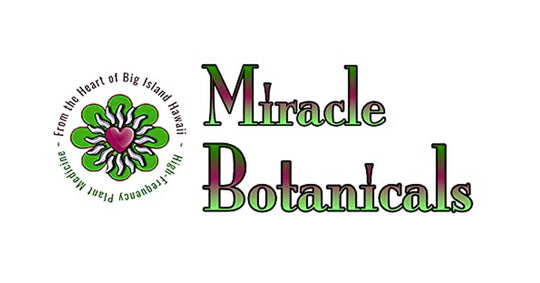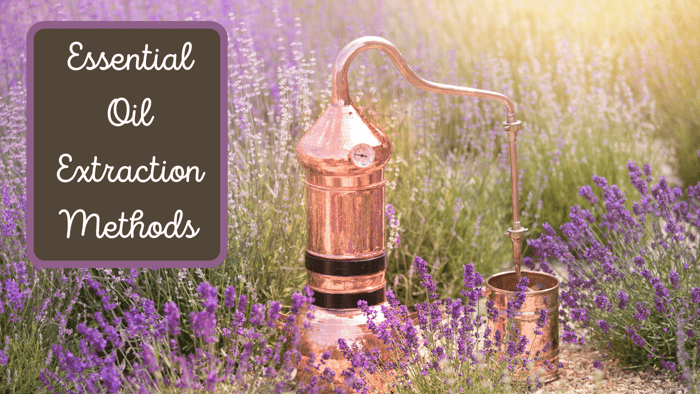I was motivated to offer a description of the different essential oil extraction methods, and how they are used so that you can understand which one might be right for you.
At Miracle Botanicals, our oils are collected through a few different essential oil extraction methods, mostly steam distilled, Co2 extracted, and cold-pressed. Sometimes, we even sell multiple types of products extracted from the same plant. For example, our Myrrh CO2 extract and steam-distilled Myrrh essential oil.
At the time of this writing, we have only one oil obtained through absolute extraction, and that is Cocoa, the only absolute we found that was not extracted using hexane (more on this below under the heading, "Absolutes").
Table of Contents
A bit of background
Many plants contain volatile aromatic chemicals in their leaves (such as eucalyptus), flowers (lavender), bark (cinnamon), or roots (angelica). These aromatic chemicals are what give these plants their characteristic aroma.
There are different ways of getting those chemicals out of the plant and into a form that we can use for emotional, physical, and spiritual healing. Today, we will cover 4 of these different ways of essential oil extraction methods: steam distillation, CO2 extraction, absolute extraction, and cold pressing.
The thing to know is that each different essential oil extraction method will produce a slightly different aromatic product, with a different chemical profile, a different aroma, and different therapeutic benefits and safety considerations.
In other words, you'll have to get informed about each individual product from each plant separately. And yes there can be significant differences between them. As a quick example: one recent scientific study found that the CO2 extract and steam-distilled essential oil of a rare plant only shared 11 compounds, while at the same time, there were a total of 50 other compounds that were only found in one of the two products.
That said, let's dive in to the specific ways of essential oil extraction methods.
Steam Distillation
This is the most common way of producing aromatic products that are used in aromatherapy. In fact, most oils you might be familiar with, such as lavender, rosemary, geranium, or frankincense, are steam distilled.
Here's how steam distillation works. First, the plant material goes into a big metal vat. Then, steam passes through the plant material and takes out some of the aromatic chemicals. Finally, the steam cools off in another vat, and the essential oil separates as a layer on top of the water that's condensed from the steam.
 There are a few important consequences of the actual process of steam distillation.
There are a few important consequences of the actual process of steam distillation.
First, steam distillation can only get aromatic chemicals that aren't too heavy. There might be other aromatic chemicals in the plant, but if their molecular weight is too great, steam distillation cannot carry these chemicals away.
Second, essential oils extracted by steam distillation are almost entirely water-insoluble (that's why they separate on top of the water in the final step).
A third point is that steam distillation requires high heat during the process, and this can affect the final product. For example, chamazulene, the blue anti-inflammatory chemical that gives oils like German chamomile their unique dark blue color, is actually created from another chemical (matricin) thanks to the heat of the steam distillation process.
Fourth, because of the heat, there are some plants that cannot be steam distilled. For such plants, other methods need to be used to get their aromatic chemicals into a workable product. One example is vanilla bean- theres no steam-distilled vanilla essential oil, but there are other aromatic products such as our Vanilla CO2 extract.
Cold pressing
Cold pressing is a completely different process from steam distillation. It is normally only used for creating citrus oils such as lemon, grapefruit, orange, or mandarin.
Cold pressing basically involves pricking the peel of the citrus fruit and then collecting the aromatic compounds that are released. There are different ways that this can be accomplished. Here's a video that illustrates the commercial production of mandarin oil:
Like steam distillation, cold-pressed oils are almost entirely water-insoluble. Again, this is because of the way that they are made: water is used to collect the aromatic chemicals that are released from the plant, and the essential oil is what separates on top of the water (you can see this process in the video above).
It's important to note that cold pressing will extract slightly different chemicals from steam distillation. As an example, steam-distilled grapefruit essential oil does not contain furanocoumarins (chemicals that can cause phototoxicity), while cold-pressed grapefruit essential oil does contain them.
At Miracle Botanicals, we only carry cold-pressed citruses because steam-distillation of citruses causes oxidation, which not only ruins the aroma, but it takes away from the therapeutic properties of the oil and adds toxicity to the oil.
CO2 extracts
Carbon dioxide (CO2) is a natural gas that's present in the air all around us. We also exhale CO2 when we breathe.
The remarkable thing is that while CO2 is a gas, the gas is transformed into liquid in a pressurized environment.
This kind of pressurized, liquid carbon dioxide can then be used to extract volatile chemicals from plant materials. When the pressure goes back to normal, the CO2 evaporates, leaving behind only the extracted plant oils.
CO2 extraction is a relatively new process. However, it is a very high-quality method of creating aromatic products, and is growing in popularity as an alternative to steam distillation for producing top aromatic oils.
At Miracle Botanicals, we adore Co2-extracted essential oils and we have an extensive collection of essential oils extracted using this method.
Here's a video of a CO2 Extraction of Frankincense:
Absolutes
 Absolutes are the result of a two-step process. First, a solvent, usually toxic hexane, is used to extract plant materials and to produce a waxy substance known as a concrete. Then, ethanol is used to extract the liquid absolute out of this concrete.
Absolutes are the result of a two-step process. First, a solvent, usually toxic hexane, is used to extract plant materials and to produce a waxy substance known as a concrete. Then, ethanol is used to extract the liquid absolute out of this concrete.
Absolutes differ from other aromatic plant products in several ways. First, they pull a broader range of compounds out of the plant, including pigments and heavier chemicals that couldn't be extracted by such methods as steam distillation.
As a consequence, absolutes are frequently less expensive than steam-distilled essential oils or CO2 extracts, because they can be created with a smaller quantity of plant material.
For the same reason, absolutes sometimes have an aroma that is closer to the actual plant than other aromatic products. On the flip side, they might offer lower concentrations of certain beneficial chemicals that are present in greater amounts in steam-distilled oils and traces of the solvent chemical.
$22.00
Botanical Name: Theobroma Cacao
Plant Part: Dried (Unroasted) Bean
Method of Extraction: Hexane-Free Solvent Extraction
Country of Origin: France
Color/Consistency: Opaque Rich Brown with Thick Consistency
Aroma: Chocolaty, Sweet, Warm, Exotic
Perfumery Note: Middle
… read moreCocoa Absolute Oil - Hexane Free (Theobroma Cacao)

Miracle Botanicals doesn't carry any essential oils with traces of toxic solvents in them.
That's why we don't offer any absolutes for sale, except for our Cocoa, which was extracted using only food-grade ethanol, not hexane or any other chemical that's considered to be toxic.
So which one is right for you?
Each of these four essential oil extraction methods has its uses and benefits.
Steam-distilled and cold-pressed essential oils are the best studied, and there is extensive research on their main compounds. Also, they have been used by aromatherapists for decades, and their uses, benefits, and safety issues are well-known.
Absolutes can make a great alternative to steam-distilled products, particularly for very expensive oils (such as rose) in cases where the intended use is perfumery. However, aromatherapists don't recommend absolutes for aromatherapy because of the traces of hexane.
Finally, CO2 extracts are the new kid on the block. Some experts believe CO2 extracts have a finer aroma than steam-distilled oils, and that these products represent the future of aromatherapy.
At the same time, the newness of CO2 extracts means that experts have had less opportunity to study them in as much detail as they have studied steam-distilled essential oils. As a consequence, we know less about how CO2 extracts benefit our bodies and our minds.
Ultimately, it's worth trying multiple aromatic products even from the same plant. For example, you might find that you prefer the aroma and benefits of a steam-distilled oil in some cases, while a CO2 extract might be better for you in other situations. Hooray to the various wonders of essential oil extraction methods!







